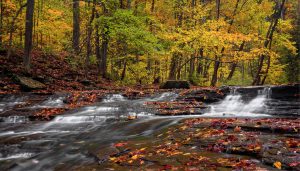Flowing downstream across the fertile Corn Belt, and bordering the States of Indiana and Illinois to the north and Kentucky to the south, the mighty Ohio River nurtures a hilly landscape dotted by large woodlands generally characterized as mesophytic forests, either of the “Beech / Maple / Linden” type, or the “Oak / Hickory” type. Shagbark hickory, Big-leaf shagbark hickory, and Bitternut hickory are all cousins of the Walnut. A species of hickory native to the southern United States, the Pecan tree prefers slightly warmer places and gives tasty nuts that are eaten as snacks. The walnuts are represented in Group 16 by the Eastern black walnut, a species in the same taxonomic family, and Butternut or White walnut. Among the oaks are species that can hardly be recognized as oak because of their narrow, lance-shaped, unlobed leaves: the Laurel oak and the Willow oak. Here and there in the understory we find clusters of Snowdrop, False Indigo, Bottlebrush buckeye, Witch hazel, Dogwoods and Serviceberry. The Southern catalpa tends to settle on the ground, after which the branches shoot upright again and form small trees.


